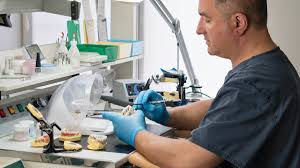Scheduling an appointment with your dentist for a routine checkup or treatment maintains your oral health. With advanced dental technology, you receive more accurate treatments and benefit from improved care. These innovations focus on enhancing your experience and supporting lasting results. Here are some of the changes in dental technology and how they impact your oral health:
Digital X-Ray Imaging
Some dental concerns begin in areas that a standard exam can’t fully reveal, such as between teeth or below the gumline. Dental X-rays help your dentist examine spaces that are hidden by soft tissue or bone. They are capable of detecting cavities, infections, and other issues that may not be visible during a visual check.
Your dentist can review the results right away and walk you through any areas of concern. This gives you a more active role in your dental care, helping you make more informed treatment decisions. X-rays are retained for comparison, allowing your practitioner to monitor your progress at every appointment.
Composite Fillings
A dentist may use filling materials designed to blend seamlessly with your natural tooth structure. Composite fillings are made from a tooth-colored resin that can be shaped and polished to match the surrounding enamel. This allows your provider to restore areas affected by decay or wear while preserving the natural look of your tooth.
The process involves cleaning the affected area and applying the composite in layers. Your dentist cures each layer with a special light, allowing for precise shaping and control. They then adjust the final texture and bite to match your natural teeth. This level of detail helps the filling fit comfortably and maintain its appearance over time, whether placed on a front tooth or a back molar.
Porcelain Crowns
Your dentist may use crown technology to reinforce a tooth that has lost part of its structure. Porcelain crowns are designed to cover the entire surface of a tooth, correcting its alignment. Specialists can use them when a filling isn’t sufficient to support the remaining tooth or after procedures such as root canal treatment. The crown is carefully shaped to fit your bite and blend with your surrounding teeth.
Treatment begins with tooth preparation and the creation of an impression to guide the design of the crown. A temporary crown may be placed while the permanent one is being crafted in a dental laboratory. Once ready, your dentist checks the fit, evaluates how it bites against opposing teeth, and makes final adjustments to promote proper balance.
Root Canal Therapy
You may need root canal treatment if the soft tissue inside your tooth becomes damaged due to deep decay, a crack, or trauma. Your dentist uses root canal technology to remove the affected pulp and clean the narrow canals within the tooth. The goal is to eliminate the infected or inflamed tissue while preserving the natural structure of the tooth.
Visit a Dentist
When you visit a dentist who uses updated tools, you may experience shorter appointments and more efficient procedures. Advanced technology, such as digital scanners and imaging systems, helps your provider capture accurate data and plan treatments with enhanced precision. These innovations facilitate early detection, informed care, and tailored treatment plans. Schedule your visit today with a dentist who uses the latest dental technology.
- FREHF – The Revolutionary Future Of Human-Centered Technology!
- Adsy.Pw/Hb3 – Boost Your SEO And Drive More Traffic!
- Fitness Based Vacations By Timeshealthmage.com!
- TimesHealthMag Tips For Improving Sleep Quality – Expert Advice For Better Rest!
- How TimesHealthMage Helps Improve Your Lifestyle Habits!


Leave a Reply